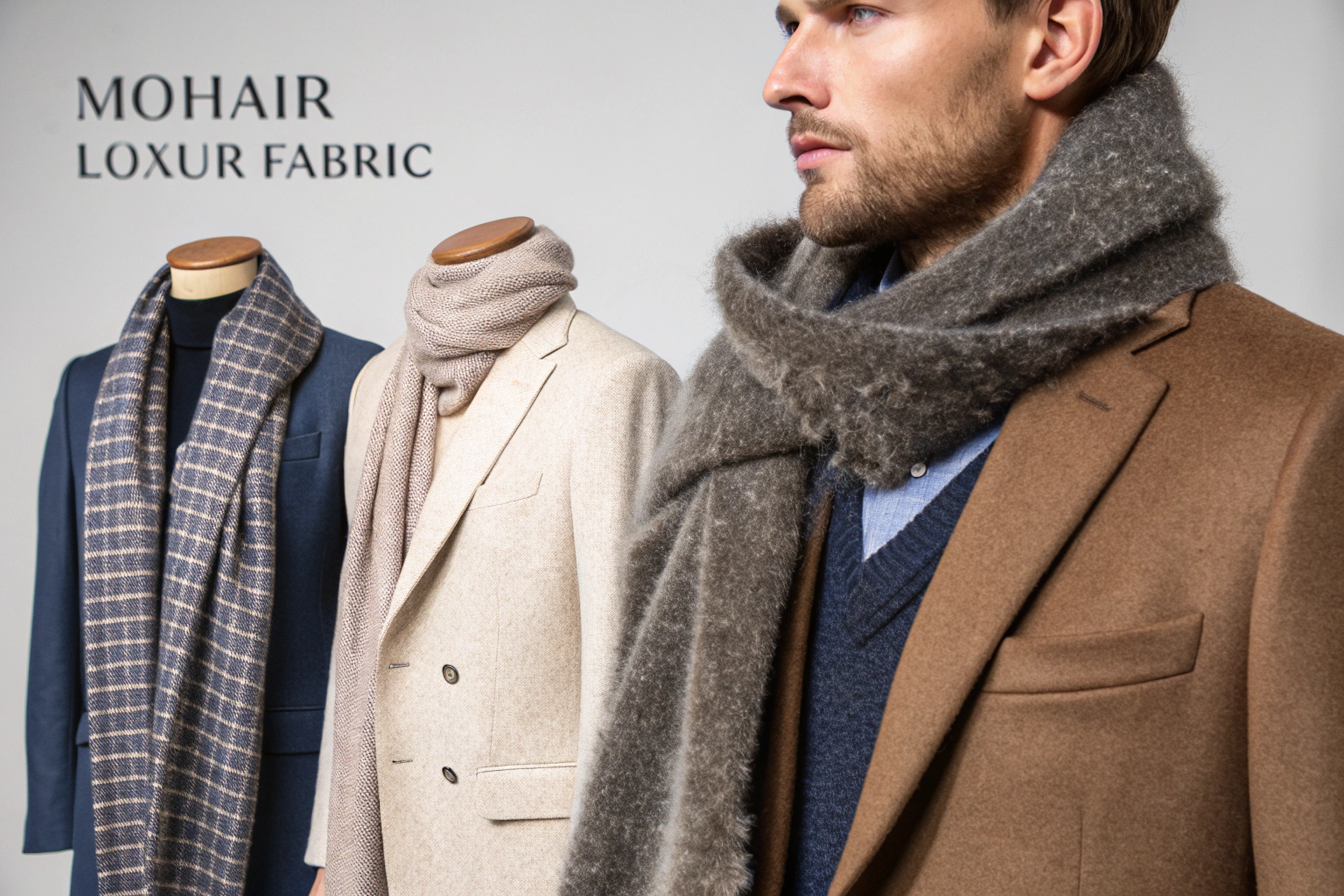Mohair fabric, known for its luxurious sheen and exceptional softness, is a topic that often comes up when I speak with designers and brands looking for that special material to elevate their collections. Many of our clients, especially those targeting the high-end market, are curious about its practical applications beyond just being a "premium" fiber. They want to know how it can be integrated into real-world designs that sell.
Mohair fabric is primarily used in fashion to create luxurious, warm, yet lightweight garments such as high-end sweaters, suits, scarves, and accessories, prized for its distinctive luster, durability, and unique insulating properties. Its ability to blend beautifully with other fibers like wool and silk makes it a versatile choice for designers aiming to add a touch of sophistication and texture to their creations. Unlike many other specialty wools, mohair's hollow fibers provide warmth without heaviness, making it ideal for year-round layering pieces.
Understanding the specific uses of mohair can help you make informed sourcing decisions, ensuring your products stand out for both quality and design. Let's explore the key applications that make this fiber a perennial favorite in the fashion industry.
What are the benefits of using mohair wool?
When you're sourcing fabrics for a new line, the core question is always about value. What does this material bring to the final product that justifies its cost? With mohair, the benefits are tangible and directly impact the garment's performance and perception.
The key benefits of using mohair wool include its exceptional durability, natural luster, excellent dye absorption, and superior insulating properties despite its light weight. This combination of aesthetics and functionality is rare. For you, this means creating garments that not only look expensive and feel soft but also last longer for the end-consumer, enhancing brand reputation for quality. Its resilience against pilling and stretching ensures the product maintains its new look after multiple wears and washes.
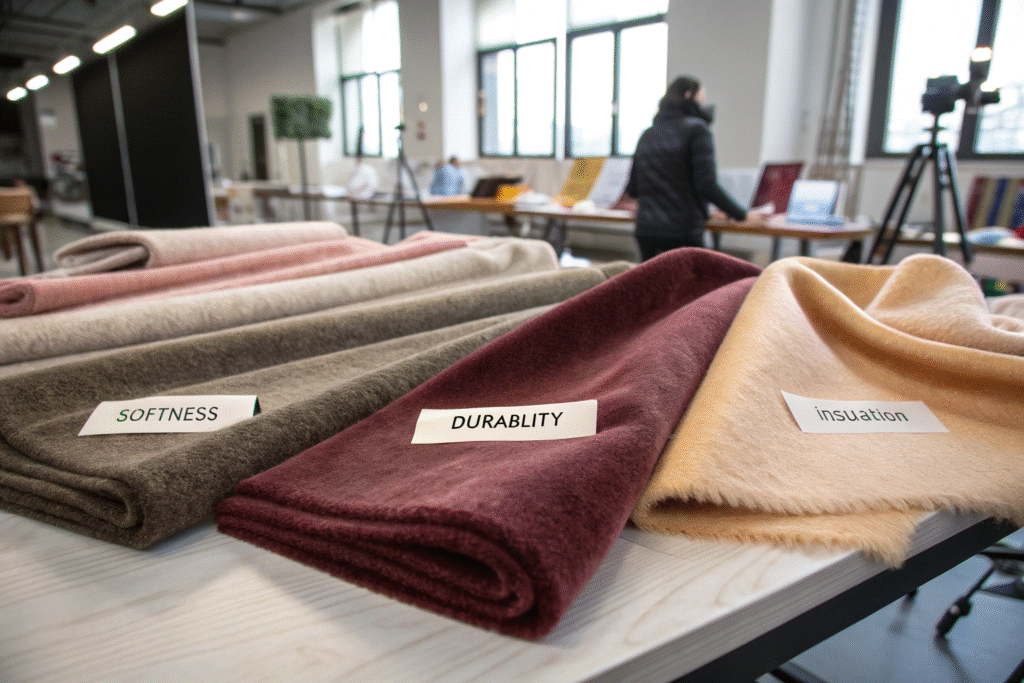
Why is mohair so durable and long-lasting?
Mohair fibers are remarkably strong, much stronger than sheep's wool. This inherent strength comes from the long staples of the Angora goat's hair. In our own quality control at Fumao, we see that fabrics with a high mohair content withstand abrasion tests significantly better than many other wools. This translates directly into garments that resist pilling and hold their shape over time. For your brand, using durable materials like mohair can lead to higher customer satisfaction and fewer returns. Furthermore, its natural elasticity allows for comfortable stretch and recovery, a crucial factor in items like fitted sweaters or socks. This durability is a key reason why mohair is often used in high-traffic areas of garments or blended with other fibers to enhance their longevity.
How does mohair provide warmth without weight?
The secret lies in the structure of the mohair fiber. Each fiber is semi-hollow, trapping air within itself. This creates a natural thermal barrier that insulates the wearer effectively without the bulk associated with other warm fabrics. This property is a significant advantage when designing elegant, lightweight winter coats or travel-friendly layers that need to be packable. At our CNAS-certified lab, we test the thermal conductivity of our fabrics, and mohair consistently performs exceptionally well. This makes it an ideal choice for your autumn/winter collections where warmth is key, but a heavy, bulky feel is undesirable. Blending mohair with silk or fine merino wool can further refine this property, creating fabrics that are incredibly light, warm, and drape beautifully.
What types of clothing are best made from mohair?
Knowing the benefits is one thing; applying them to specific products is another. Choosing the right garment types for mohair is crucial for maximizing its potential and ensuring commercial success.
Mohair is ideally suited for knitwear such as sweaters and cardigans, luxurious suiting and blazer fabrics, warm scarves and shawls, and high-quality pile linings for coats. Its unique texture and drape make it a favorite for statement pieces that command attention. When you choose mohair for these applications, you are signaling a commitment to quality and luxury that discerning customers recognize and appreciate.
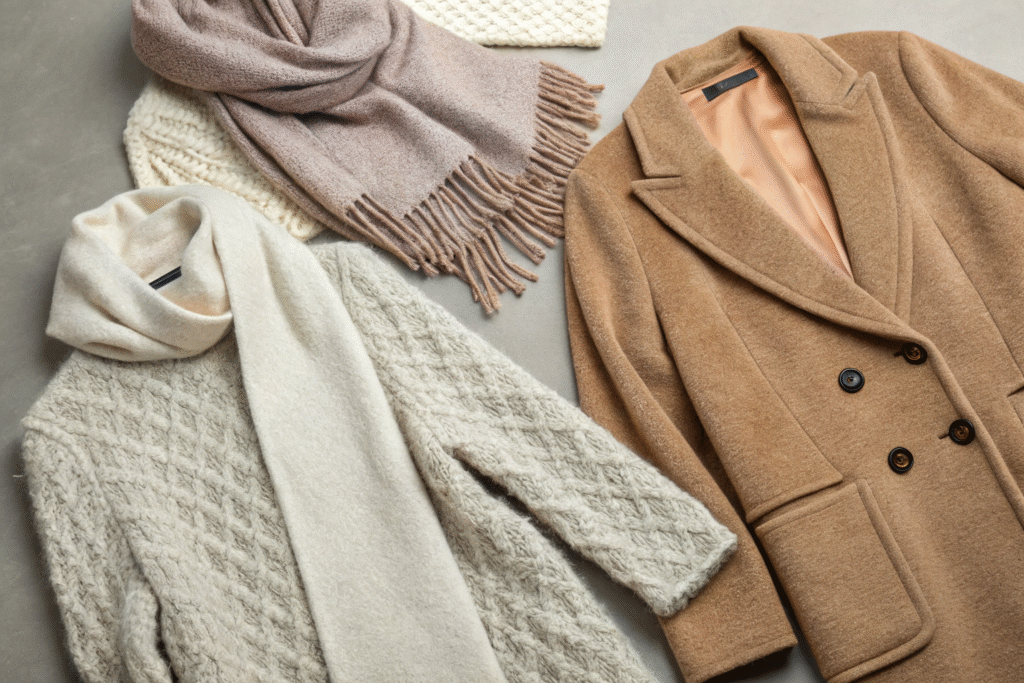
Is mohair good for sweaters and winter wear?
Absolutely. Mohair is a superstar in the knitwear category. Its ability to create fluffy, soft, and incredibly warm yarns makes it perfect for sweaters, cardigans, and winter accessories. The fluffy halo of mohair yarn adds a visual depth and softness that is highly desirable. For your brand, this means you can create winter garments that are not only functional but also have a distinctive, fashionable texture. We work closely with our clients to develop mohair blends that balance softness with structure, ensuring the sweaters are comfortable against the skin and maintain their shape. Because mohair is less prone to felting than sheep's wool, it offers more flexibility in care, a point you can highlight to your customers. Blending it with a small amount of nylon can further enhance the durability of sweaters intended for more active use.
Can mohair be used for suits and formal attire?
Yes, and it's a mark of high-end tailoring. When woven (rather than knitted), mohair creates a sleek, crisp fabric with a distinctive sharp luster. Mohair-blend suit fabrics are renowned for their resistance to wrinkling and ability to hold a sharp crease. This is a major benefit for travel suits or for anyone who needs to look polished throughout a long day. For your suiting line, incorporating mohair can significantly elevate the perceived quality. These fabrics are often blended with wool to add body and reduce cost, while still retaining the signature sheen and resilience. We help our clients source the right blend, often guiding them towards fabrics with 10-30% mohair content for optimal balance of aesthetics, performance, and cost-effectiveness, perfect for creating formal wear that stands out.
How is mohair fabric produced and sourced?
Understanding the journey from raw fiber to finished fabric is essential for making ethical and quality-conscious sourcing decisions. It also helps in communicating the value of your products to your customers.
Mohair fabric production begins with shearing Angora goats, primarily in South Africa and the USA, followed by sorting, scouring, and spinning the fibers into yarn, which is then woven or knitted into fabric. The sourcing and processing stages are critical to determining the final quality, softness, and sustainability credentials of the fabric. At Fumao, we prioritize traceability and work with suppliers who adhere to ethical animal husbandry practices, ensuring the mohair we use meets high welfare standards.
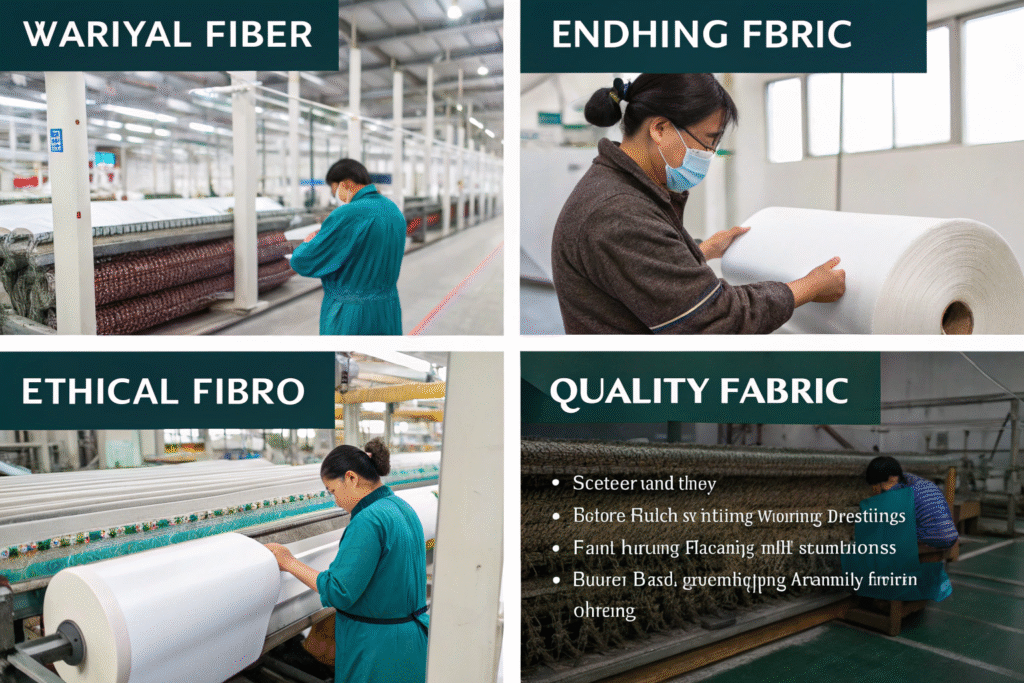
What is the difference between kid mohair and adult mohair?
The age of the goat is the primary factor determining mohair's quality and price. Kid mohair, from the first or second shearing of a young goat (under 6 months), is the finest, softest, and most valuable type. The fibers are thinner and shorter, resulting in a fabric that is exceptionally soft and less prone to itchiness. This is the preferred choice for luxury garments worn directly against the skin. Adult mohair, from older goats, is thicker, stronger, and more lustrous. It is often used in outerwear, rugs, or blended with other fibers where extreme softness is less critical. When you specify "kid mohair" in your product descriptions, it immediately communicates a higher tier of quality and luxury to your customers. We help our clients navigate these choices to find the right fiber for their budget and application.
What certifications should I look for in mohair sourcing?
For responsible sourcing, key certifications to look for include the Responsible Mohair Standard (RMS), which ensures the wool comes from farms with high animal welfare and land management practices. Additionally, Oeko-Tex Standard 100 certification is crucial for the finished fabric, verifying that it is free from harmful substances. At Fumao, our in-house CNAS-accredited lab rigorously tests for these parameters, and we provide all necessary documentation to our clients. This due diligence not only mitigates risk for your brand but also aligns with the growing consumer demand for transparent and ethical supply chains. Sourcing certified mohair can be a powerful part of your brand's sustainability story.
How to care for and maintain mohair garments?
A common concern for brands is how a delicate-looking fabric will perform in the hands of the consumer. Providing clear care instructions is key to maintaining customer satisfaction.
Mohair garments require gentle care: hand washing in cold water with mild detergent or dry cleaning is recommended; they should be laid flat to dry away from direct heat and stored folded to avoid stretching. Proper care preserves the fabric's softness, shape, and luxurious appearance for years. Educating your end-customers on these simple steps can greatly enhance their experience with your product and protect your brand's reputation.
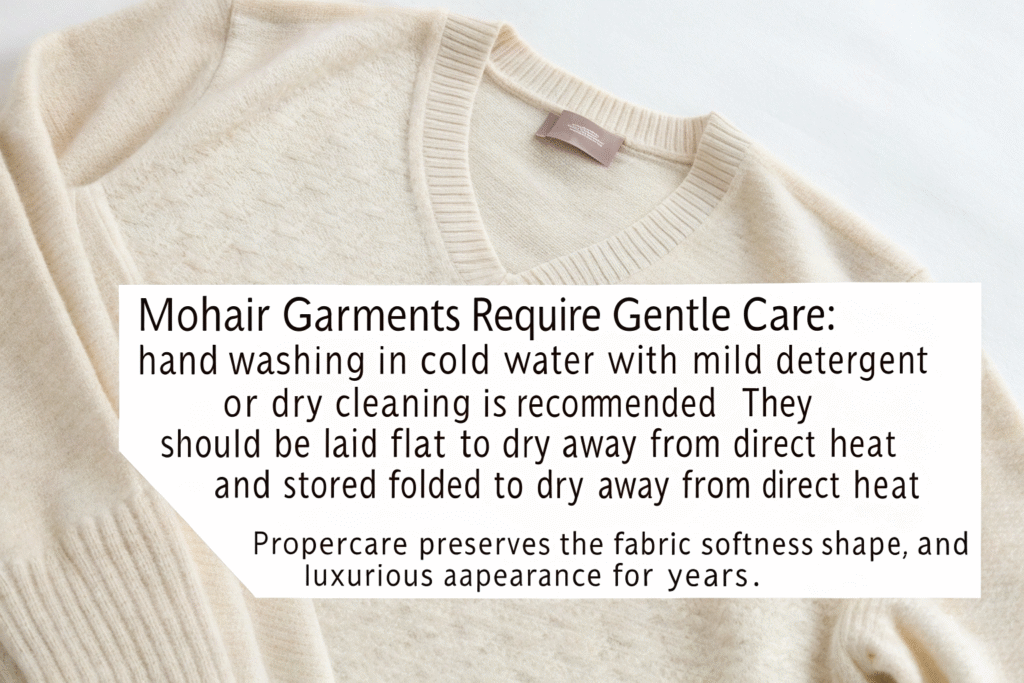
Can you machine wash mohair?
It is generally not advisable. The agitation of a washing machine, even on a gentle cycle, can cause mohair fibers to felt or become misshapen. The best practice is always to recommend hand washing. This ensures the garment retains its original texture and size. For your product lines, including clear "Hand Wash Only" care labels is essential. At Fumao, we can perform wash tests on specific fabric blends during the development stage to provide you with precise and reliable care instructions for your labels. This proactive approach minimizes the risk of garment failure after purchase and builds trust with your customers.
How to prevent pilling on mohair sweaters?
While mohair is durable, some pilling can occur in areas of friction, like under the arms. The best prevention is proper construction and blending. We advise our clients on the optimal yarn twists and blend ratios (e.g., adding a small percentage of nylon) that minimize pilling without compromising softness. For the consumer, advising them to store mohair garments folded instead of on hangers, and to avoid rough surfaces like backpack straps, can help. If pills do form, they can be gently removed with a cashmere comb or a battery-operated fabric shaver. By addressing this common concern upfront, you demonstrate a deep understanding of your product and its lifecycle.
Conclusion
Mohair fabric stands as a testament to how natural fibers can offer an unparalleled combination of beauty, function, and longevity. From its role in creating sumptuously soft knitwear to its application in crisp, durable suiting, mohair provides designers with a versatile tool to differentiate their brands in a competitive market. Its unique properties—warming without weight, shining with a subtle luster, and resisting wear—make it a smart investment for collections aimed at discerning customers who value quality.
Ultimately, successfully incorporating mohair into your line comes down to partnering with a supplier who understands its nuances from source to finish. This ensures not only the quality of the fabric but also the ethical integrity of your supply chain. If you are looking to develop a clothing line that leverages the exceptional qualities of mohair, we have the expertise and supply chain to guide you from concept to delivery.
For a conversation about how we can help you produce your next clothing order with high-quality mohair fabrics, please contact our Business Director Elaine at elaine@fumaoclothing.com. We look forward to weaving your vision into reality.

